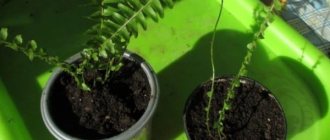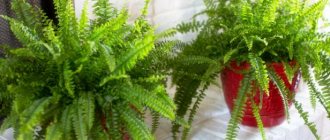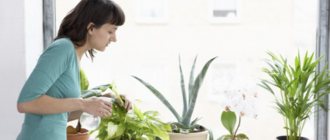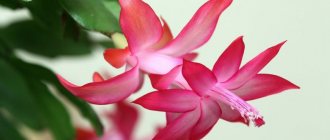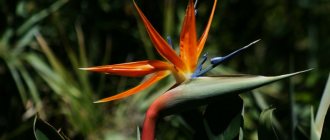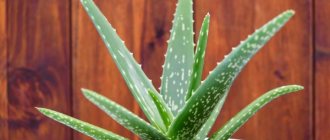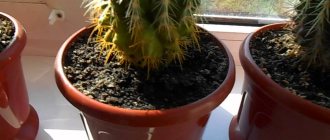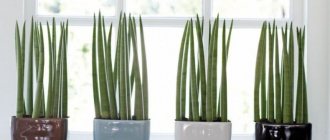A bright and attractive Dieffenbachia with luxurious striped leaves native to South America. The genus is named after the Austrian botanist Joseph Dieffenbach, who was head gardener at the Imperial Botanical Garden in Vienna in the 19th century.
All types of Dieffenbachia are evergreen plants from the Araceae family. In nature, they can grow up to 2 m, and can grow to the same size in an apartment. So you need a lot of space for this flower. The leaves are large, with spots and streaks, which gives them a special chic. But despite its beauty, Dieffenbachia can rarely be found in our apartments, because almost mystical powers are attributed to this plant. The chairman of the Moscow Flower Growers club, a collector of ornamental flowering plants, Tatyana Zhashkova, told us about the features of this plant
signs
People who are accustomed to looking for an explanation for their problems and troubles in the position of the planets, a horoscope and some mystical laws, often ask what, in an esoteric sense, threatens the appearance of Dieffenbachia in the house.
It is better to contact a fortune teller, psychic or astrologer with this question, but there are a couple of signs about Dieffenbachia that many people know about. So, for those who don’t know these signs: they say that Dieffenbachia, along with hibiscus, is the strongest “husband-killer”. To this I can answer that such nonsense contradicts the law of photosynthesis and common sense. In addition, if you look for a bad sign or bad omen in everything, you thereby attract problems, misfortunes and other negativity to yourself. Dieffenbachia is just a beautiful plant, that’s how it should be treated
Pay attention to cats: they happily eat Dieffenbachia leaves, since for them it is just an anthelmintic
floristics.info
History and name
An evergreen exotic plant belonging to the aroid family, has a 150-year history. This family includes not only 30 species of Dieffenbachia, but also philodendron, monstera, alocasia, anthurium and others. Where did Dieffenbachia come to us from? The plant’s homeland is North and South America, and therefore it is not surprising that the crop prefers a humid and warm climate.
You may be interested in: Hygrophila Schisandra: description, features, cultivation
The genus got its name in honor of Joseph Dieffenbach, the chief gardener of the imperial palace in Vienna. After the discovery of America, traders and travelers were fascinated by this plant and often took it to other continents, where it quickly gained popularity due to its unpretentiousness. In its homeland, the Dieffenbachia plant is considered an evergreen perennial shrub.
We select comfortable conditions
Dieffenbachia - home care, propagation of
Dieffenbachia Seguina
In order for indoor Dieffenbachia to always remain well-groomed and decorative, you should strictly adhere to the simplest growing rules. Even a beginner will be able to do them:
- A dieffenbachia flower grown at home requires a lot of light, but light shading should be done from direct rays, for example, using a curtain. It is not recommended to place this exotic plant in a dark corner, as the leaves will become small and dull. You can keep it in partial shade, but if you move significantly away from the window, it may lose its decorative effect. White-leaved specimens are considered more demanding in terms of lighting. In winter, the plant needs at least 10 hours of daylight. If you do not provide additional lighting, the tips and edges of the leaves will dry out.
- Watering should be plentiful. The condition for excellent growth is the constant moisture of the earthen clod; it should not dry out. Watering is organized twice a week in the summer season; in winter, the plant is limited to 1 moistening every 7-9 days. In summer, it responds well to daily spraying; in winter, when the temperature is cool, it is better to exclude them. If the plant has stopped growing, then in the spring it can be watered with warm water at +38°C.
- When organizing care for exotic plants, it is recommended to regularly wipe the foliage from dust and take a warm shower. At home, you can often observe a plant “crying.” This happens when the air in the room is humid and the roots absorb a lot of liquid. When the air is dry, water quickly evaporates from the leaf blades, and when the air is humid, the accumulated juice rolls off the leaves in drops. To eliminate this behavior, you need to slightly reduce watering.
- The temperature for growing is room temperature. Dieffenbachia, which prefers systematic care, does not like low temperatures. Therefore, temperatures below +18 °C are stressful. With a sharp decrease in temperature indicators, massive leaf fall may begin.
- If the pet eventually bares the stem, then rejuvenation will need to be organized. It is better to plan the procedure for spring, when active growth of shoots begins. It needs thorough pruning, leaving only a stem 10 cm high. It is covered with a glass jar to create favorable conditions. After 2-3 weeks, the plant will delight with new shoots.
- A houseplant, the cultivation of which can be entrusted to a beginner, does not have a clearly defined dormant period, so fertilizers should be applied all year round. In summer and spring this is done twice a month, in winter the interval is increased to once every 35-40 days. They are fertilized with mineral fertilizers suitable for decorative foliage plants; some gardeners prefer the Vito preparation. You can also use rotted manure: take one part of it and add 2 parts of water, leave to ferment for 2 weeks. After filtering, the solution is diluted 1:5 and fed the next day after watering. Specimens with light foliage grow more slowly, so 1 feeding per month is enough for them.
Lovely
The leaves of Dieffenbachia charming, compared to many other species, are elongated in length and have a less pronounced rounded shape. The light pattern along the lateral veins on the leaf plate resembles a herringbone. The contrast of the background and dark green edges makes the plant very attractive. Good lighting makes the pattern even brighter and more noticeable. If elongated spots, white stripes, and strokes occupy most of the sheet, this species is called “Tropical Snow.”
Characteristic flowering
Tabernemontana - home care
The inflorescences of Dieffenbachia, like all its aroid relatives, bear a vague resemblance to an ear of corn. The flowering period begins in mid-spring. Not every gardener can see how Dieffenbachia blooms. The inflorescence appears from the leaf axil and has a veil, usually cream-colored, but sometimes greenish in color. But in indoor conditions it is quite difficult to see a flowering Dieffenbachia bush, because this happens rarely and lasts only a few days. Afterwards, the cob withers, but remains on the bush and does not fall off. In this state, it takes energy away from the plant and can inhibit its further growth, so it is recommended to cut it off yourself. If pollination occurs, and in our latitudes there are insects capable of this, then the cob gives way to bright red or orange berries, which look very impressive, but have poisonous properties.
Sources
- Dieffenbachia // The Plant List (https://www.theplantlist.org/1.1/browse/A/Araceae/Dieffenbachia/)
- Visyashcheva L.V., Sokolova T.A. Industrial floriculture. Textbook for technical schools // M.: Agropromizdat, 1991 – 368 p.
- Dr. Hessayon D.G. All about indoor plants // M.: Kladez-Buks, 2002 – 256 p.
- State catalog of pesticides and agrochemicals approved for use on the territory of the Russian Federation as of July 6, 2022 // Ministry of Agriculture of the Russian Federation (https://mcx.gov.ru/ministry/departments/departament-rastenievodstva-mekhanizatsii-khimizatsii -i-zashchity-rasteniy/industry-information/info-gosudarstvennaya-usluga-po-gosudarstvennoy-registratsii-pestitsidov-i-agrokhimikatov/)
When and how to replant Dieffenbachia
Areca palm chrysalidocarpus - home care
Dieffenbachia is transplanted as the root system grows, at least once every 3 years, into soil for indoor plants with the addition of charcoal. After planting the plant in another pot, it needs regular feeding - once a week from April to August. It is during this period that the process of formation of new foliage and improvement of the general condition of the flower occurs. Plants with unattractive bare stems are also successfully replanted. After planting in a new pot, after some time the stem must be cut off, leaving a stump 10 cm long, from which new shoots will begin to appear over time.
Conditions for lush growth
Caring for this plant at home is not difficult. Although for many both experienced gardeners and beginners, plant care is still not completely clear.
After acquiring Dieffenbachia, planting it or transplanting it at home, it is necessary to determine its permanent location. This should be a well-lit room in winter and autumn. In summer, it is better to place the flower in a shaded place, but so that there is daylight. Because constant shade can lead to the loss of bright and unusual variegation of leaves. Direct exposure to sunlight is also not recommended, as this causes the leaves of Dieffenbachia to turn yellow. A variety such as Dieffenbachia camilla requires strict temperature conditions. In spring and summer, a temperature of 22 degrees is ideal for it. With high air humidity, the flower can withstand temperatures above 30 degrees.
With the onset of winter, the plant needs to be provided with cooler air - about 18 degrees.
Dieffenbachia reacts very poorly to temperature changes and ventilation. This requires proper care, and if you decide to ventilate the room, it is better to take the plant to another room for this time.
The main care for Dieffenbachia mix consists of abundant watering during the period of its active growth. Moreover, experienced gardeners recommend standing the earth ball in water for about 15 minutes once a month. Then allow the water to drain. Even in winter, this flower needs regular and abundant watering, but so that there is no stagnation of water. Flooded plants are immediately visible. Their leaves begin to turn brown or yellow.
Caring for Dieffenbachia also includes regular moisturizing. This is a moisture-loving flower, and it simply needs frequent spraying with settled water. Weekly showers will help the plant's leaves get rid of dust. When the air temperature is above 20 degrees, it is recommended to place the plant on wet gravel or peat. The flower uses nutrients very actively. Timely care is especially needed here. Dieffenbachia requires regular feeding (once every 10 days) with mineral fertilizers, which are used for all indoor plants.
Difficulties in caring for Dieffenbachia
Dieffenbachia is a plant that can be affected by various diseases and pests. The cause of many diseases is illiterate care.
Insufficient lighting, irregular or excessive watering can lead to the loss of the decorative appearance of the flower, as well as to its diseases. The leaves turn yellow and dry - this is a sign that the air is too cold for the plant, or there have been too large temperature changes, or the soil is simply dry.
The appearance of spots on the foliage or a change in their color indicates direct sunlight on the flower, or the Dieffenbachia is in conditions of too bright lighting.
Spraying with green soap, weak tobacco infusion, and insecticides helps very well in the fight against spider mites. After each treatment, Dieffenbachia leaves must be washed thoroughly. If necessary, the spraying procedure is repeated. You can also watch a video about all the pest control methods for this plant. By observing all the conditions of maintenance and cultivation, as well as giving the plant proper care, you can create a whole greenhouse from different varieties of Diefenbachia at home.
Benefits and harms
The sap of the plant is poisonous and can cause irritation if it comes into contact with exposed skin. In case of accidental contact with mucous membranes, the glands and tongue swell.
All work with flowers (transplanting, pruning, etc.) is best done with thick rubber gloves, and upon completion, wash your hands well with soap. You should not keep it in the children's room, or in a place where the child can reach it.
At the same time, the lovely Dieffenbachia cleanses the air from many harmful substances: xylene, benzene, and various formaldehydes.
Also good for purifying the air: Anthurium, Ficus Benjamin Kinki, Peperomia obtufolia, Hoya Carnosa, Decorative deciduous Begonia, Dracaena Fragrance, Dieffenbachia Spotted and some others.
Home care
In nature, the plant grows in the tropics of Mexico and Argentina. For growing at home, you can find many varieties of Dieffenbachia in stores; species have large, oblong, oval-shaped leaves and variegated colors. Depending on the variety, there are small tabletop plants that are placed in the kitchen or tall ones that grow up to two meters.
If Dieffenbachia appears in your home, caring for it at home is easy:
- Lighting. Place the plant on the floor or windowsill with good sunlight, shade the window if necessary. Remember that direct sun burns the leaves, too bright light discolors them. Due to lack of light, new leaves grow small and are located far apart on the stem. Rotate the plant pot regularly to provide full light to all sides. Remember that although most varieties develop well even in low light without losing their decorative appeal, however, their growth is slower or stops.
- Temperature: 15–23°C (all year round). The plant does not tolerate drafts (from doors, windows or air conditioners). This is one of the reasons why Dieffenbachia leaves turn yellow.
- Watering. The soil should be kept constantly moist, but not soggy. In summer, water abundantly, and in winter - moderately, when the top layer dries to a depth of 5 - 7 cm between waterings. Spray the plant every day (in winter, place it away from the radiator).
- Feeding. It is carried out only when the plant is actively producing new leaves (from March to October). Most indoor plants - like Dieffenbachia - are fed every two weeks in the summer and once a month in the spring and autumn. In winter, do not feed, otherwise the edges of the leaves will darken due to an excess of fertilizers in the soil.
- Soil: peat moss plus perlite (2:1).
- Pot size. Caring for Dieffenbachia at home includes spring plant transplants. If the roots fill the pot, it is replaced with a new one, which should be only 2.5–5 cm wider.
- Trimming. The need for such a procedure appears in two cases: when the trunk is bent (the plant was not turned to the light on one side or another in time), or becomes bare (the lower leaves have fallen due to problems with watering or drafts). The trunk is cut with a sharp, clean knife at an angle of 45 degrees (about 15 cm above the surface of the soil in the pot and half a centimeter above the bud - a small swelling near one of the brown rings on the trunk where the leaf was attached, at each such point new growth begins). The plant is then watered well to restore it after pruning. In 5–6 months, 4 new trunks with leaves grow from the cuttings, with which it can again reproduce.
Reproduction of Dieffenbachia at home
Photo: YouTube
Dieffenbachias reproduce well vegetatively and there are 2 methods that give excellent results.
Apical cuttings. In this case, cut off the top of the plant, tear off the lower leaves, if any, and plant the cuttings in a mixture of sand and sphagnum moss in equal proportions (2).
Stem pieces. It is better to root them in a mixture of sand and soil, also in equal proportions (2). Each piece should have 2–3 internodes. The stem sections are laid horizontally on the ground and covered with film or glass.
Both propagation options give best results in summer and late December. Cutting cuttings and pieces of stems is best combined with pruning the plant.
Plant nutrition
It is also important to add mineral fertilizers to the soil - for this it is best to use universal liquid products that are suitable for any deciduous plants. Care, supplemented by fertilizing, makes it possible to grow strong and tall Dieffenbachia at home, which will become a real decoration for your home.
Care, supplemented by fertilizing, makes it possible to grow strong and tall Dieffenbachia at home, which will become a real decoration of your home.
However, there is also a restriction on the use of fertilizers - they cannot be applied if the plant’s leaves turn yellow, as this will lead to a further deterioration of their condition.
Diffembachia: a dangerous plant (video)
Many amateur gardeners prefer Dieffenbachia due to the fact that they highly value the beneficial properties of this decorative indoor crop. The benefits of the plant are due to its chemical composition, which helps improve the indoor microclimate and alleviates the condition of people suffering from allergies or diseases of the respiratory system. It is important to note that with age, Dieffenbachia acquires a palm-like appearance, which not all gardeners like, but is a characteristic feature of almost all types of this ornamental plant.
What to pay attention to when growing
Despite the fact that Dieffenbachia has excellent decorative characteristics, is easy to care for and grows quickly, you need to be careful when choosing a place to install it. The fact is that all parts of this plant are poisonous, so Dieffenbachia is not suitable for children's rooms, institutions, and kitchens. The most toxic part of the flower is its juice. It is white in color, and in direct contact with the skin, it can cause a burning sensation and irritation, which can be relieved by rinsing the skin area with running water. If it happens to get on the tongue, it swells and the ability to speak clearly is lost. Local residents of the South American continent use it to make poison for rats.
Dieffenbachia - impact on humans
With proper care, Dieffenbachia does not cause harm, but benefit. It can be considered a kind of indicator of the energy situation: it helps not only to identify negativity, but also to neutralize it.
Just keep in mind that Dieffenbachia should share its energy only with those who care for it and cherish it. She gives greater preference to the fair sex, which is why it is better for a woman to work with this plant. The flower will improve your well-being and help fight cellulite and signs of aging.
In addition, the plant has a very good effect on a person who is doing business or building a career. It helps to make informed decisions, assimilate information, rationally manage capital and make the right use of business contacts.
Magical, insidious, poisonous, spectacular - so many epithets, and all about one plant. Signs about Dieffenbachia say that the plant is not suitable for everyone and can create a positive atmosphere in the house only with proper care. If you have concerns about this plant, it may be worth getting another green friend. After all, fear itself makes a person vulnerable to negativity.
Dieffenbachia flower features
A common feature of all Dieffenbachia is a thick, succulent stem bearing large, oval leaves. The leaf of this plant is an amazing creation of nature, although breeders have made their contribution to the creation of many varieties and hybrids with different leaf colors. The growing point of Dieffenbachia is usually located at the top of the shoot, although there are species in which the dormant points are located at the base of the shoots, and therefore they are capable of bushing.
The inflorescence of representatives of this genus, like other Araceae, is in the shape of a spadix, but Dieffenbachia rarely blooms at home. And it’s not the flowering that interests flower growers: the flowers attract the eye with the beauty of their large, variegated leaves. Dieffenbachia is a unique plant. Get acquainted with a number of features that distinguish this indoor flower:
- – Dieffenbachia is poisonous, so pruning and replanting of the plant must be carried out while observing safety measures;
- – grows very quickly – under favorable conditions, it produces a new leaf weekly, but as it grows, its trunk in the lower part becomes bare, the plant loses its decorative appearance, and it has to be cut off and then rooted;
- – does not tolerate sudden cold snaps and drafts at all and loves moisture very much;
- – does not tolerate lime, so water for irrigation and spraying must be settled or filtered. You can use rain or boiled water.
These not very attractive properties of Dieffenbachia, however, do not detract from its undeniable advantages, the most important of which is beauty and impressiveness.
What is important to consider when caring for Dieffenbachia
Dieffenbachia is a tall plant. In nature, it can reach two meters in size and even more. Dieffenbachia strives for this at home, so over time it requires powerful support. As it grows, the lower part of the stem of a “mature” plant becomes woody, the lower leaves fall off and the plant somewhat loses its decorative appearance. In this case, the plant is rejuvenated, the top is cut off and rooted, the stem is cut into cuttings and they are also rooted. You can rejuvenate the plant as follows: cut the plant completely, leaving only a short stump; after a few months, new young shoots will begin to appear from it.
general information
Dieffenbachia owes its difficult name to the German botanist Dieffenbach. In nature, it grows in South America, like many other similar species. Outwardly, it resembles not a shrub, but a small tree with a full-fledged trunk, from which large leaves spread out densely.
Dieffenbachia has one interesting growth feature - it grows only from above. Therefore, gradually the lower leaves will die off, and the stem will become more and more like a bare trunk. In this form, the flower can stretch even several meters. But this happens infrequently, because for all its visual impressiveness it is very fragile.
Photo: lesnaya-aptechka.ru
In fact, Dieffenbachia is a flowering plant, but this happens extremely rarely at home. To do this, you really have to work hard to recreate suitable conditions. In this case, the flowers bloom every year, and thanks to artificial pollination they can even bear fruit.
Please note that the leaves and stems of Dieffenbachia have quite poisonous juice. It won’t harm you in any way at home, but if it gets on your mucous membrane, it can cause a serious burn. Therefore, it is better not to keep the flowerpot where small children or pets can reach it.
Photo: happymodern.ru
Types of Dieffenbachia
The most common cultivated species are spotted Dieffenbachia (Dieffenbachia maculata) and variegated or painted Dieffenbachia (Dieffenbachia picta) - plants with large succulent stems and elongated oval leaf plates with obvious venation, reaching a width of 12 cm and a length of up to half a meter. Their bright green leaves are dotted with white spots and stripes.
They differ from each other in that variegated Dieffenbachia grows up to two meters in height, and spotted Dieffenbachia does not exceed a meter, but its leaves are slightly larger in size and they are more pointed at the top. It was Dieffenbachia spotted that became the basis for most varieties and hybrids bred by breeders. Here are some of the most popular cultivated varieties of Dieffenbachia spotted:
- – variety “Vesuvio” - an elegant medium-sized plant with narrow, delicate white leaves and green specks on white petioles;
- – Dieffenbachia “Camilla” is one of the hardiest bushy varieties, which is why it has earned popularity among amateurs. Lanceolate, creamy-white leaves are edged with a light green rim. Young leaves have a greenish tint;
- – Dieffenbachia “Compact” – a neat, dense bush with green leaves with light specks along the central vein.
Dieffenbachia leopoldii species
- a low-growing plant native to Costa Rica with a short and thick stem, pale green short petioles with purple spots and dark green elliptical leaves up to 35 cm long with a pronounced white central vein.
Dieffenbachia amoena
Flower lovers like it for its unpretentiousness and excellent adaptability to home conditions, since it tolerates dry air and the proximity of heating devices better than other types. In addition, its decorative qualities are beyond any criticism: height up to one and a half meters, large dark green oval leaves up to 60 cm long with white stripes along all veins.
Dieffenbachia seguina,
which amateurs often confuse with Dieffenbachia spotted, has wider – up to 16 cm – leaves with fewer lateral veins than Dieffenbachia spotted. This species has also produced many varieties and hybrids, for example, “Tropic Snow” - a never-out-of-fashion cultivar with a regular pattern on the leaves formed by yellow spots, while the central vein and edges of the leaves remain dark green.
Dieffenbachia oerstedii
- a species with uniformly green, heart-shaped or pointed leaves with a distinct light central vein. The length of the leaves is 30-35 cm. The most famous hybrid of this species is “Green Magic”, a dense bush of small size with unusually colored leaves: they are dark bluish-green with a white central vein. There is a form with small light specks along the leaf blade.
Large-leaved (Dieffenbachia macrophylla)
- the only species with uniformly green leaves and veins, the shape of the leaf blade is ovoid, the midrib is thickened. This species grows up to one meter in height.
- a species with the largest leaves among Dieffenbachias, up to 70 cm long, dark green in color with small light specks.
Threats to the comfortable growth of a flower
Dieffenbachia flowers do not require complex care. The most important thing is to ensure a comfortable temperature regime and a stable microclimate. Hypothermia and drafts risk negatively affecting the well-being of the plant.
Dieffenbachia is also sensitive to long periods of lack of moisture or excessive watering. It is necessary to know and maintain a balance. Therefore, you need to carefully study how to water a flower.
If the conditions of detention are violated, Dieffenbachia may get sick. Often in this case, the tips of the leaves dry out or yellow spots appear. This is a sure sign that the plant is not feeling well.
Often the flower is attacked by parasites. Therefore, it is important to observe suitable growing conditions, as well as carry out pest prevention.
Features of care
Growing an exotic beauty is quite difficult, since it is very capricious and demanding of care. In order for house plants to actively grow and fully develop, it is necessary to strictly follow the rules for caring for them.
Watering
To water Dieffenbachia, it is recommended to use boiled or settled water. In the warm season, it is necessary to water the indoor flower often and abundantly. In winter, the plant is watered as the soil dries.
Lighting
When choosing a place to grow Dieffenbachia, it is necessary to take into account its variety. A plant with variegated leaves needs bright sunlight, but an indoor beauty with a monochromatic leaf color prefers shaded places. During the cold season, be sure to take care of artificial lighting.
Temperature
Dieffenbachia spotted does not tolerate sudden changes in temperature and drafts. In summer, the air temperature should be between 20-25 degrees; in winter, do not allow temperatures below 16 degrees. The flower loves fresh air, so ventilate the room regularly. While airing, take the indoor beauty to another room.
Air humidity
The exotic flower loves water treatments, so spray it regularly. For spraying, use water at room temperature. During spraying, it is recommended to cover the soil with film to avoid waterlogging.
Top dressing
During the active growth phase, the flower needs nutrients. During this period, you need to feed the plant once every ten days. Fertilizers should not contain lime. It is highly not recommended to feed Dieffenbachia with organic matter, as this can affect the color of the leaves.
Dieffenbachia transplant
As already mentioned, the exotic beauty is a very capricious indoor plant, so during transplantation the following rules must be observed:
- The plant needs to be replanted only if its root system has entwined the pot.
- The ideal time for transplantation is winter and spring.
- If for some reason it is necessary to replant a flower at another time of the year, it is recommended to use the transshipment method. This method will protect the root system from damage.
- You should not choose a pot that is too large for replanting; the Dieffenbachia flower does not feel comfortable in large pots.
- For replanting, it is recommended to use a substrate that should include: peat, moss, garden soil and sand. This soil is ideal for Dieffenbachia because it allows water and air to pass through well.
- When replanting, be sure to place a drainage layer at the bottom of the pot.
Pest and disease control
Houseplants rarely suffer from pests, especially if you regularly wash the leaves. But it is still impossible to be one hundred percent insured against spider mites or scale insects. In this case, good old insecticides and a regular soap solution for washing will come to your aid.
Most often, Dieffenbachia owners encounter rot or fungus. They arise from an excess of moisture in the soil and too low a temperature. Then you need to dig up the plant, remove all damaged roots, treat the cuts with charcoal and transplant the flower into new soil, after having spilled it with a weak solution of potassium permanganate.
Photo: domashniecvety.ru
Possible problems
Pests and diseases
The most common pests that settle on domestic Dieffenbachia are: scale insects, thrips, spider mites, aphids and mealybugs. You can try to get rid of them mechanically: thoroughly wash the foliage and stem of the plant with a sponge moistened in a soap solution. In this case, the soap solution must be washed off the bush with running water. If there are a lot of pests, then the plant should be treated with a solution of Karbofos or Actellik (15 drops per 1 liter of water).
It happens that Dieffenbachia develops bacteriosis. It manifests itself in the formation of watery areas on the foliage that have clear boundaries. This disease is bacterial, and a diseased bush cannot be cured. This perennial can also suffer from root rot. First, the part of the bush located underground rots, and then the foliage and shoots. The plant may die. After areas with a grayish coating appear on it, it is necessary to immediately take the necessary measures: reducing watering, replacing the soil mixture, spraying with a solution of a systemic fungicidal preparation.
Dieffenbachia turns yellow
Often, inexperienced gardeners are faced with the problem of yellowing foliage. As a rule, this occurs as a result of violations of the rules of crop care, as this leads to weakening of the plant and an increase in the likelihood of it being damaged by pests or diseases.
Most often, the foliage of Dieffenbachia turns yellow if the bush is exposed to a draft or the room is too cold. Yellowing can also be caused by a lack of nutrients in the soil or watering with high hardness water. The foliage also turns yellow if the plant becomes infected with root rot.
Why do Dieffenbachia leaves turn yellow? Causes of yellowing leaves.
What causes it to dry out?
Dieffenbachia may also begin to dry out. If the lower leaf plates turn yellow, dry out and fly off, then there is no need to worry, since this process is considered natural. If the trunk is significantly exposed, it is necessary to carry out rejuvenation; for this, cuttings are cut and rooted. However, if young leaf blades dry out, this is most likely due to exposure to cold, draft, or the bush is regularly watered too sparingly.
Dieffenbachia withers
If the foliage has lost its turgor, and the soil mixture in the pot is dry, this means that watering is carried out very rarely. But if the soil mixture is wet and the foliage is limp, then most likely this is due to root rot. If rot is detected from the roots, the entire substrate must be carefully removed. Cut out rotted areas using a very sharp, sterilized tool. Sprinkle all cut areas with ground cinnamon or charcoal powder. Next, the bush is planted in fresh soil mixture. In the future, it needs to be watered more rarely and less abundantly.
Oersted
A bushy plant with a strong, thick and branched stem. The long (up to 35 cm) leaves located on it are elliptical, and in some varieties they are oblong or heart-shaped, usually painted in a rich green color. The entire leaf blade of Oersted's Dieffenbachia is crossed by a light stripe. This plant must be replanted every two years and undergo anti-aging pruning. In addition, this flower loves spraying and well-lit places, however, direct sunlight should not fall on it. Temperatures below +15 °C and drafts are undesirable for it.
Pests
- Despite its toxicity, the plant is affected by aphids. The poison of the plant does not affect the health of the insect. The condition of the tree is weakened, the leaves may fall off. Aphids carry some diseases that will further weaken the plant.
- Spider mite. It is very small and cannot be seen immediately. But it is noticeable that the leaves wither and become covered with cobwebs.
- Shield. When infected by this pest, the leaves become discolored and brown pimples, similar to warts, are clearly visible on them.
- Mealybug. First, the leaves begin to fall off, and then the entire plant dies.
To combat harmful insects, you need to use a soap solution. With a napkin soaked in it, you need to very carefully clean the leaves and stem. Also, there are chemicals against all these pests.
Some care tips
Its decorative effect greatly depends on the quality of plant care.
There are some secrets that experienced flower growers will use:
- It happens that the new leaf is still in the bosom, but has already begun to unfold. As a result, the sheet may tear. When this happens, you need to take soft threads and tie the leaf so that it does not open yet. You need to untie it after leaving the bosom. Then the edges of the sheet will be smooth and undamaged, and the appearance will be decorative.
- It happens that a leaf grows quickly, but its opening occurs slowly. This indicates a lack of nutrition. The tree just needs to be fed.
- If flowers and seeds are not needed, then it is better to cut off the flower stalks immediately so that the decorative bush is not weakened and develops normally.
- When the pot with soil is large, the tree will grow larger. But there is no need to take too large sizes, as only the roots will grow. And then the leaves will begin to grow.
Why do Dieffenbachia leaves dry out and turn yellow?
As it grows, the leaves in the lower part of the stem begin to turn yellow and fly off. But if this happens not at the bottom, but at the top, then this indicates that the plant is cold or is standing in a draft.
Why does it rot?
Excess moisture and poor drainage contribute to rotting of the root system. If this happens, then you need to cut off everything rotten or even radically cut off the top and root it, and it is better to throw away the entire lower part so as not to lose the entire flower.
Why do the leaves turn pale?
If the leaves suddenly become too pale, a possible reason is that the plant is exposed to direct sunlight. It should be moved to a more suitable place or shaded.
Why does Dieffenbachia cry?
Yes, there is such an interesting feature ! This is not at all scary under normal conditions, as it evaporates excess moisture after watering. If there is a lot of this moisture, then the droplets will directly roll off the leaves; if watering is normal, then the foliage will simply be wet.
Camilla
Another popular variety of Dieffenbachia, which came to us from the tropical forests of South America. This species grows up to two meters in length. On a strong stem there are large, oblong leaves, which are white closer to the middle, with a green border along the edge. With age, white spots disappear from the leaves of Dieffenbachia macrophylla. Camilla develops quickly - a new leaf grows within a week. In a ventilated room, protected from drafts, a shaded corner will be the best place for this plant.
Precautions and advice from gardeners
We mentioned that Dieffenbachia juice (the variety does not matter) is poisonous; it can cause severe allergic reactions - skin irritation, burns of mucous membranes. After each contact with flower juice, you should thoroughly wash your hands, and carry out all agricultural activities with gloves. If your family has very small children or pets, hold off on getting this plant.
A flower indoors can live for a very long time, but with age, the lower part of its stems becomes bare and becomes less attractive. Replace the flower with a fresh one in a timely manner, using apical cuttings.
The plant perfectly purifies indoor air from harmful impurities, such as xylene and toluene. This beautiful and not too demanding plant will fit perfectly into any interior and will delight all household members with its unusual appearance for a long time.
Source
Reproduction
To propagate Dieffenbachia, apical cuttings no more than 12 cm long are used. They must be cut only with a disinfected sharp knife and after pruning it is imperative to treat the cut areas with an antiseptic. To do this, use charcoal or activated carbon, crushed into powder.
Remove the lower leaves from the cutting to reduce moisture loss and dip it in rooting powder ("Kornevin") with the lower end, then place it in moistened soil. Place the pot with the cuttings in a warm place (+21 °C) and cover the top with a glass jar to create a greenhouse effect. Every day the plant should be ventilated, removing the jar for about half an hour. Rooting occurs after a month and a half.

